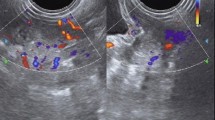Summary
9 patients with regular trisomic Down's syndrome, 3 female carriers from different t (DqGq) families and 2 carriers from the same t (21q22q) family were examined by quinacrine dihydrochloride fluorescence microscopy. A G group chromosome with a highly fluorescent band on its long arm was found in triplicate in all patients. The same chromosome was missing in the (DqGq) translocation carriers being involved in the translocation with a D chromosome. It was also missing in the (21q22q) carriers. This supports the suggestion that it is always the same chromosome which is involved in both regular and translocation Down's syndrome.
Quinacrine dihydrochloride is an easily available stain, which can be used for identification of human metaphase chromosomes.
Similar content being viewed by others
References
Capoa, A., de, Miller, O. J., Mukherjee, B. B., Warburton, D.: Autoradiographic studies on a mother and aborted foetus from a family with four mongoloid children and a presumptive 21/21 translocation. Ann. hum. Genet. 31, 243–253 (1967).
Caspersson, T., Farber, S., Foley, G. E., Kudynowski, J., Modest, E. J., Simonsson, E., Wagh, U., Zech, L.: Chemical differentiation along metaphase chromosomes. Exp. Cell Res. 49, 219–222 (1968).
—, Zech, L., Modest, E. J., Foley, G. E., Wagh, U., Simonsson, E.: Chemical differentiation with fluorescent alkylating agents in vicia faba metaphase chromosomes. Exp. Cell Res. 58, 128–140 (1969).
—, Johansson, C., Modest, E. J.: Identification of human chromosomes by DNA-binding fluorescent agents. Chromosoma (Berl.) 30, 215–227 (1970).
—: Analysis of human metaphase chromosome set by aid of DNA-binding fluorescent agents. Exp. Cell Res. 62, 490–492 (1970).
Gilbert, C. W., Muldal, S., Lajtha, L. G., Rowley, J.: Time sequence of human chromosome duplication. Nature (Lond.) 195, 869–873 (1962).
Mikkelsen, M.: Familial Down's syndrome. Ann. hum. Genet. 30, 125–146 (1966a).
—: Transmission of a 13–15/21 translocation in six families. Ann. hum. Genet. 30, 147–161 (1966b).
—: G Group chromosomes: Birth defects. Original Art. Series 5, 50–58 (1969).
Pearson, P. L., Bobrow, M., Vosa, C. G.: Technique for identifying Y chromosomes in human interphase nuclei. Nature (Lond.) 226, 78–80 (1970).
Penrose, L. S.: A suggested use of dermatoglyphic analysis in mongolism. In Wolstenholme and Porter (Eds.): Mongolism. Ciba Foundation Study Group No. 25, pp. 41–46. London: Churchill 1967.
Vogel, W., Höhn, H., Engel, W.: Autoradiographische Identifizierung der an zentrischen Fusionen beteiligten D-Chromosomen bei fünf nichtverwandten Familien: t(14qGq); t(14qGq); t(15qGq); t(13q14q); t(13q15q). Humangenetik 9, 140–149 (1970).
Walker, N. F.: A suggested association of mongolism and schizophrenia. Acta genet. (Basel) 6, 132–142 (1956).
Yunis, J. J., Hook, E. B., Mayer, M.: Identification of the mongolism chromosome by DNA replication analysis. Amer. J. hum. Genet. 17, 191–201 (1965).
Zech, L.: Investigation of metaphase chromosomes with DNA-binding fluorochromes. Exp. Cell Res. 58, 463 (1969).
Author information
Authors and Affiliations
Rights and permissions
About this article
Cite this article
Mikkelsen, M. Identification of G group anomalies in Down's syndrome by quinacrine dihydrochloride fluorescence staining. Hum Genet 12, 67–73 (1971). https://doi.org/10.1007/BF00291036
Received:
Issue Date:
DOI: https://doi.org/10.1007/BF00291036




